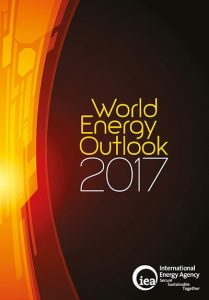What’s happening and going to happen in global energy sector?……….the report that every energy enthusiast waits for, is out!

World energy outlook 2017 focuses on four large shifts in global energy system. These are, rapid deployment and falling price of clean energy technologies, rapid electrification of energy, shift to a more service oriented economy and cleaner energy mix in China, and resilience of shale gas and tight oil in US.
In the new policies scenario this year,
Global energy demand rises slowly but a 30% rise between now and 2040. India would contribute as high as 30% of the demand rise and its use of energy would rise to 11% of the global use, by 2040.
Population increases from 7.4 billion of today to more than 9 billion by 2040,
Renewable would capture two thirds of global power investment by 2040 and share of renewable will be 40% in total power generation boosted by rapid solar PV deployment in China and India. In EU renewable will be 80% of new capacity, growing after 2030, wind leading the front. Competitive auction will take over feed in law with policy support for renewable continuing worldwide.
Electricity consumption will rise by 40% in 2040. Rising income would mean a rise in electrical appliances in households. Population of fleet of EV would go up to 280 million by 2040 from 2 million today. Huge demand rise in electricity would bring challenges of de-carbonization power generation.
China is projected to drive the global course on fuel mix, cleaner technologies, and will lead the per capita consumption of electricity with 40% by 2040. The country will also set the global trend with quick transition to clean energy and will account for 40% global investment in EV. Coal will still remain a major fuel but its presence will decline by 15% in 2040.
US will do well in LNG and become major exporter of crude oil by mid-2020.
Surprisingly, oil demand is projected still to rise, though not sufficient for a global turnaround. Petrochemical demand grows along with demand in other sectors like trucks, aviation and shipping.
Natural gas also grows, to fill quarter of global energy demand as a cleaner source, with 80% of projected growth coming from developing countries, the long gas pipeline between China and Russia playing a part. US LNG would provide a flexible energy market, accounting for 90% of projected growth. Though gas usage rises, it will still be a less viable option for power generation and would only play a balancing role rather than baseload, in some countries like India and China.
Still, in new policies scenario, 675 million people in the world remain without access to electricity in 2030.
Effect of air pollution to health becomes severe with premature death due to air pollution rises from 3 million today to 4 million in 2040.
Policy support and actions make GHG emission by 2040 slightly lower, by 600 million ton than that predicted last year.
Emission from power sector does not increase above 5%, in spite of increased demand of electricity by 2040.
This year’s World Energy Outlook portrays a new scenario, called sustainable development scenario, which provides an integrated way to achieve three policy objectives, climate stabilization, cleaner air and universal access to modern energy, simultaneously.
It integrates energy with sustainable development. Thus, this scenario brings a complete picture of energy sector, by linking energy access with emission and health.
In this scenario, with no further change in policy action, universal access to energy happens in 2030 and 2040. Also death due to air pollution halves and net GHG emission does not increase. With universal access biomass cooking decreases, reducing emission.
The Sustainable Development Scenario combines ambitious climate policy with significant action on achieving energy access and creating cleaner air – an integrated approach that speaks to energy policy priorities in a very wide range of countries.
As per Paris agreement, it will be pursued to limit global rise in temperature to 1.5 degree C, and this scenario tries to bring a roadmap for the goal. But materialization of all such projections would depend largely on policy initiatives and investments, and innovations, both in energy and climate front, in tandem!
Source: World energy outlook 2017, published by International energy agency
